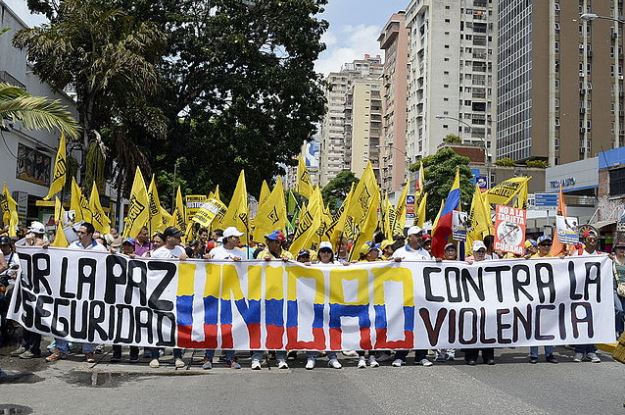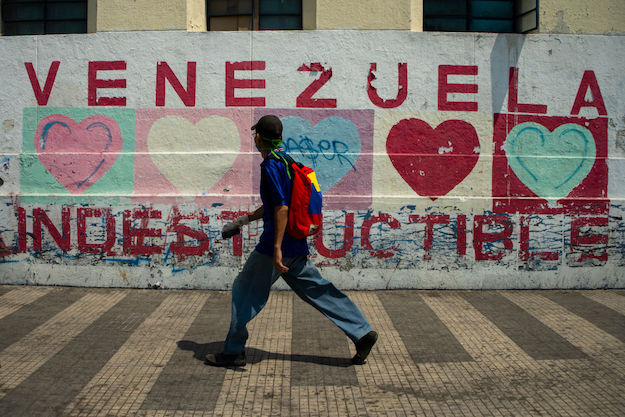Most Venezuelans taking part in today’s “mother of all marches” against President Nicolás Maduro are planning to do so peacefully. Even the country’s most outspoken opposition leaders are using the language of nonviolent resistance.
Not everyone is on board. Government security forces have cracked down violently on dissent; regime-backed paramilitary groups attacked marchers and have killed five demonstrators in protests since April 1, leading the UN High Commission for Human Rights and regional leaders to call on Maduro to respect the people’s right to assemble peacefully. As recent incidents of rock-throwing, setting fire to government buildings and sporadic looting suggest, however, some demonstrators feel compelled to respond in kind to the regime’s aggression.
A portion of the violence during recent protests can be attributed to regime forces, often police or intelligence officers, who have infiltrated demonstrations with the intent of tainting the opposition and justifying further repression. But there are indeed many in Venezuela today who believe that responding to Maduro with violence is the only way to force a change in government. I’ve written extensively on the disadvantages of this line of thinking, and the response on Twitter has been telling: “You mean to tell me that we should just march to Altamira (an upper-middle class neighborhood in Caracas) with our little flags or wherever the regime lets us?! I don’t agree with you, brother,” one person responded to me last week. Another told me that I “live in a poem” and that “every rebellion has a degree of violence in order to face the violent ones.”
Well, recent global experience – and Venezuela’s own history – show why they’re wrong. What’s more, the conditions in Venezuela today, more so than at any time in recent years, suggest that a nonviolent response to Maduro’s aggression stands the best chance of ultimately forcing a change in government.
Part of the reason for this is that the demands protesters are making of the government are more concrete than ever. In today’s march under the banner of “Elections now!” Venezuelan citizens are calling for: free and fair elections, respect for the democratically-elected National Assembly, and acceptance of humanitarian aid, which the government has systematically refused, dismissing it as an excuse for a foreign invasion. For an opposition too often attached to the “Maduro out!” call to action, a clear set of goals pointing forward is new and inspiring.
On a global level, nonviolent action has been successful against precisely the type of cruel leader that Maduro has become. From post-Soviet countries to South Africa and from the Philippines to Serbia, nonviolent action has led to regime change and democratization, even in the face of horrid repression. The Tunisian revolution has become a vivid, current example of the effectiveness of nonviolent struggle.
And historically, nonviolence has been shown to be more effective than violence in increasing costs for the regime and effecting change. The International Center for Nonviolent Conflict (ICNC) has compiled a complete resource library that provides clear evidence for the advantages of nonviolent action over violent campaigns. The work of two ICNC researchers, Erika Chenoweth and Maria J. Stephan, shows that 61 percent of violent campaigns fail in regime change, while nonviolent action fails 17 percent of the time. Moreover, transitions carried out by nonviolent means lead to more stable, lasting and peaceful democracies than those achieved through violence. On average, nonviolent campaigns attract 150,000 more members than violent ones, since violence increases the barriers for participation.
This last point is especially important in the Venezuelan case, where popular anger against the regime is now being expressed across all segments of society, even among lower-income groups that have long provided the bulwark of support for chavismo. Today’s protesters aim to promote democratic transition, and in doing so, they recognize a crucial element of nonviolent theory: that transitions are do not only a concern of political or economic elites.
In nonviolent struggle, repression often backfires on the regime, causing cracks in their ranks. Nonviolent action is particularly effective in gaining international support and causing shifts in the regime’s international support base. Far from achieving its goals, when demonstrations turn violent they: 1) significantly raise the costs of participation, decreasing the number of people willing to join; 2) stimulate greater cohesion in pro-government groups; 3) lower the costs of repression, which is then seen by police and military forces as necessary and justified; and 4) delegitimize the protest in the eyes of the international community. All of this can happen –and has happened in the past– in Venezuela.
Caveat lector, nonviolence isn’t magic. It can fail. It needs discipline, organization, clear goals, and unity of purpose. The change it achieves can be undone, as the current state of Egypt shows. However, when Venezuelans are placed at the crossroads of violence and nonviolence, they should know that the latter is by far the more likely force to usher in lasting democracy in a country in dire need of reconciliation and rebuilding.
—
Fermín is a sociologist and researcher at UCAB in Caracas.








